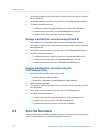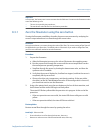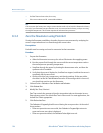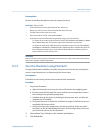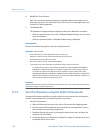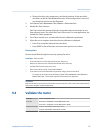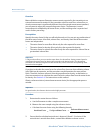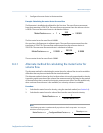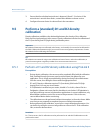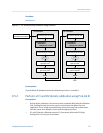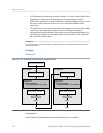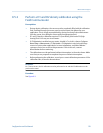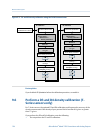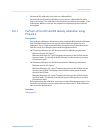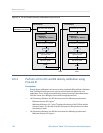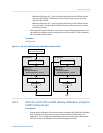
3. Ensure that the calculated meter factor is between 0.8 and 1.2, inclusive. If the
meter factor is outside these limits, contact Micro Motion customer service.
4. Configure the meter factor for volume flow in the transmitter.
9.5 Perform a (standard) D1 and D2 density
calibration
Density calibration establishes the relationship between the density of the calibration
fluids and the signal produced at the sensor. Density calibration includes the calibration of
the D1 (low-density) and D2 (high-density) calibration points.
Important
Micro Motion flowmeters are calibrated at the factory, and normally do not need to be calibrated in
the field. Calibrate the flowmeter only if you must do so to meet regulatory requirements. Contact
Micro Motion before calibrating the flowmeter.
Tip
Micro Motion recommends using meter validation and meter factors, rather than calibration, to
prove the meter against a regulatory standard or to correct measurement error.
9.5.1 Perform a D1 and D2 density calibration using ProLink II
Prerequisites
• During density calibration, the sensor must be completely filled with the calibration
fluid, and flow through the sensor must be at the lowest rate allowed by your
application. This is usually accomplished by closing the shutoff valve downstream
from the sensor, then filling the sensor with the appropriate fluid.
• D1 and D2 density calibration require a D1 (low-density) fluid and a D2 (high-
density) fluid. You may use air and water.
• If LD Optimization is enabled on your meter, disable it. To do this, choose ProLink >
Configuration > Sensor and ensure that the checkbox is not checked. LD Optimization is
used only with large sensors in hydrocarbon applications. In some installations, only
Micro Motion customer service has access to this parameter. If this is the case,
contact Micro Motion before continuing.
• The calibrations must be performed without interruption, in the order shown. Make
sure that you are prepared to complete the process without interruption.
• Before performing the calibration, record your current calibration parameters. You
can do this by saving the current configuration to a file on the PC. If the calibration
fails, restore the known values.
Restriction
For T-Series sensors, the D1 calibration must be performed on air and the D2 calibration must be
performed on water.
Measurement support
130 Micro Motion
®
Model 1500 Transmitters with Analog Outputs



